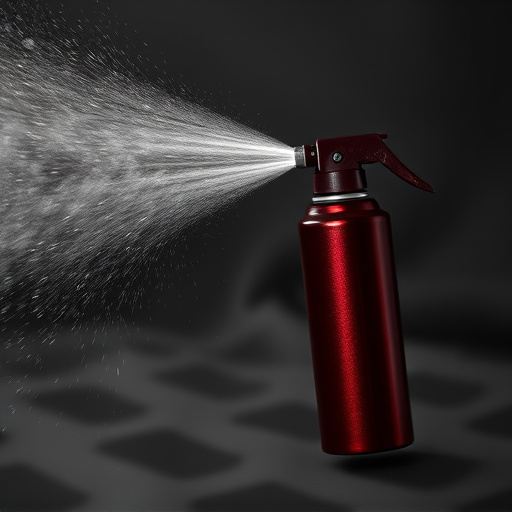Optimizing pepper spray effectiveness involves understanding capsaicin composition and following manufacturer guidelines. Protect canisters from extreme temperatures, humidity, and light to extend shelf life up to 3-5 years. Store in cool, dry, dark locations, use original packaging, and protect from moisture for maximum potency and safety. Regularly inspect for changes in spray pattern, pressure, or odors; replace if damaged or degraded for reliable emergency use.
“Riot control inflammatory spray canisters, often referred to as pepper spray, are powerful tools designed for self-defense and law enforcement. To ensure their effectiveness, understanding the chemical composition, environmental impact, and optimal storage practices is crucial. This article delves into these aspects, offering insights on how to extend the shelf life of pepper spray. By following proper storage guidelines and recognizing signs of spoilage, users can maximize their protection.”
- Understanding Pepper Spray's Chemical Composition
- Environmental Factors Affecting Shelf Life
- Storage Practices for Maximum Lifespan
- Recognizing Signs of Spoilage and Replacement
Understanding Pepper Spray's Chemical Composition
Pepper spray, a common tool in riot control and self-defense, is a powerful chemical agent designed to disable attackers temporarily. Its primary active ingredient is capsaicin, the same compound that gives chili peppers their heat. This irritant affects the eyes, nose, and respiratory system, causing temporary blindness, coughing, and difficulty breathing.
Understanding pepper spray’s chemical composition is key to optimizing its effectiveness and safety. Factors like proper storage and the use of protective gear can significantly extend the shelf life of the canister. Additionally, manufacturers often provide guidelines for users to maximize the spray’s potency over time, ensuring that each application remains potent when needed most during emergency situations.
Environmental Factors Affecting Shelf Life
Various environmental factors play a significant role in determining the shelf life of pepper spray canister. Extreme temperatures, both hot and cold, can accelerate chemical reactions within the canister, causing the active ingredients to degrade faster. Humidity levels are also critical; high humidity environments promote bacterial growth and corrosion, reducing the overall lifespan of the product. Exposure to direct sunlight or intense artificial light can lead to photodegradation, where UV rays break down the spray’s composition over time.
Proper storage conditions are essential for pepper spray canister shelf life extension. Maintaining a cool, dry place away from direct heat sources and sunlight can significantly slow down degradation. Some manufacturers also recommend keeping canisters in original packaging to protect them from dust and moisture absorption. Understanding these environmental factors allows users to maximize the effectiveness of their pepper spray equipment over an extended period.
Storage Practices for Maximum Lifespan
Proper storage practices play a pivotal role in extending the shelf life of riot control inflammatory spray canisters, or pepper spray. To maximize their effectiveness and longevity, these devices should be kept in cool, dry, and dark places. Extreme temperatures, whether scorching heat or freezing cold, can compromise the integrity of the canister and its contents. Similarly, exposing them to direct sunlight or artificial lighting for extended periods can lead to degradation.
Consider storing pepper spray in a dedicated, secure cabinet or locker, away from reach of unauthorized individuals. Maintaining consistency in storage conditions is key; sudden temperature fluctuations can cause the spray to become less potent or even fail altogether. Additionally, ensure that the canisters are not exposed to moisture or high humidity levels, as these can contribute to corrosion and damage. By adhering to these simple yet crucial storage guidelines, users can significantly prolong the useful life of their riot control inflammatory spray canisters.
Recognizing Signs of Spoilage and Replacement
Regularly inspecting your riot control inflammatory spray canister for signs of spoilage is crucial for ensuring its effectiveness and safety. While pepper spray has an extensive shelf life, typically around 3-5 years, factors like temperature extremes, exposure to moisture, or physical damage can accelerate degradation. Look out for any changes in the spray pattern, reduced pressure, or unusual odors, which may indicate spoilage.
To extend the pepper spray’s shelf life, store it properly in a cool, dry place, away from direct sunlight and extreme heat. Keep the canister sealed to prevent moisture ingress. If you notice any signs of spoilage, replace the unit immediately, prioritizing your safety and the reliability of your riot control equipment.
Extending the shelf life of a riot control inflammatory spray canister, like pepper spray, involves understanding its chemical composition, being aware of environmental influences that can accelerate degradation, implementing optimal storage practices, and knowing the signs of spoilage. By following these guidelines, users can ensure their pepper spray remains effective when needed most, maximizing its useful lifespan through proper care and stewardship.
